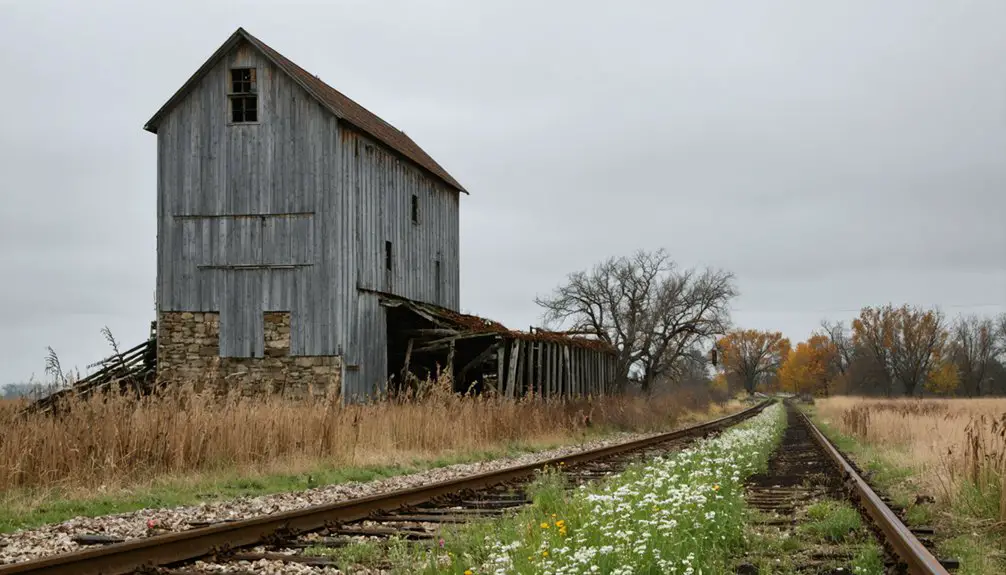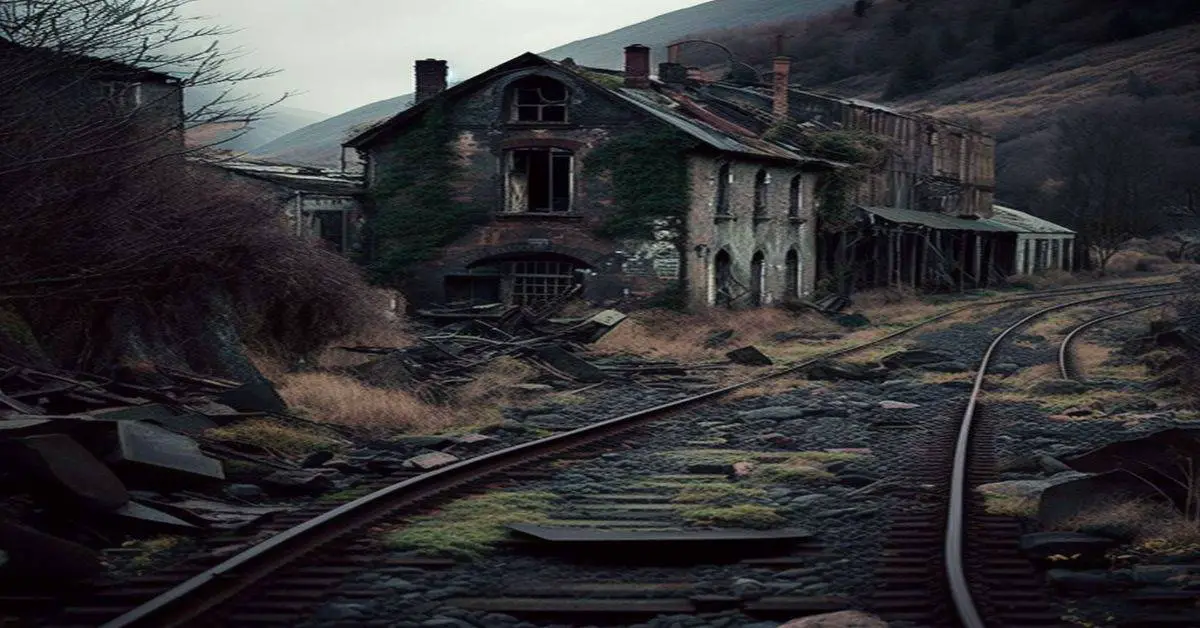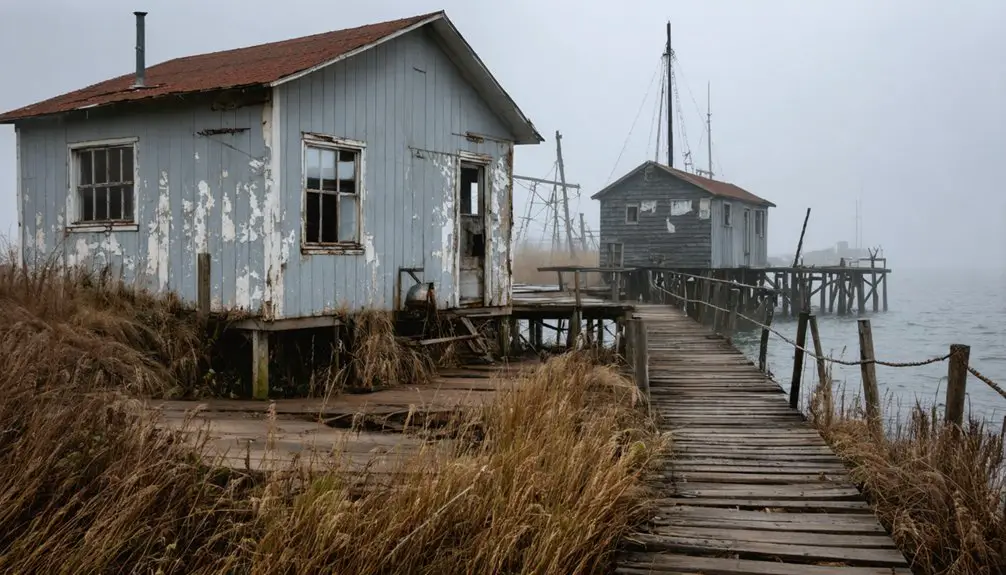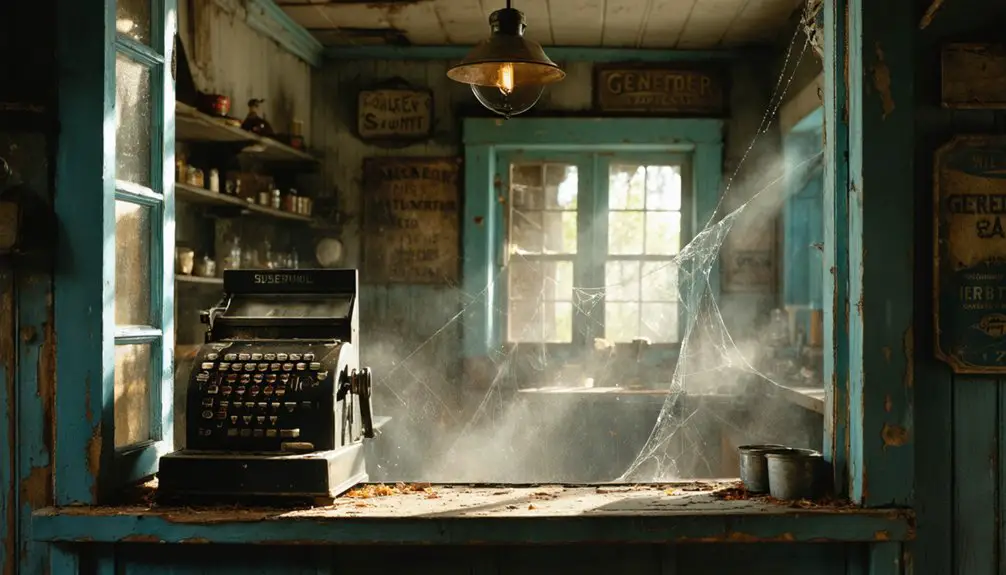You’ll find Ranney’s scattered concrete foundations where A.L. Ranney’s bustling dairy empire once thrived in rural Wisconsin. Starting in 1927, Ranney’s Dairy became famous for its ice cream and pioneered refrigerated milk delivery trucks by 1935. The town flourished until younger residents began moving to cities for better jobs, leading to its eventual abandonment. Today, only soil-buried artifacts and ground depressions mark this once-proud dairy community‘s story.
Key Takeaways
- Ranney was a thriving dairy community in Wisconsin that began in the 1920s with Ranney’s Dairy providing pasteurized milk to Tomah.
- The town’s economy centered around Ranney Neuman Co, formed in 1939 through a partnership between A.L. Ranney and Max Neuman.
- Economic decline occurred as younger workers migrated to urban centers, leaving an aging population and limited economic opportunities.
- The site is now completely abandoned, with the last structure demolished in 2003, leaving only ground depressions and buried artifacts.
- Local historical societies preserve Ranney’s legacy through digital archives, photographs, and community storytelling events.
The Rise of a Dairy Empire
When Ranney’s Dairy began providing pasteurized milk to Tomah in 1927, it marked the start of a remarkable dairy empire in southwestern Wisconsin.
The region’s transition aligned with the state’s broader shift, as dairy farming had emerged as the dominant agricultural focus after wheat’s decline.
You’d have seen their dairy innovations firsthand, as they were among the first to embrace mechanical pasteurization, ensuring safer milk for your family’s table.
The company’s growth continued until they joined forces with Max Neuman to create the Ranney Neuman Co in 1939.
Early Settlement and Community Life
You’ll find that Ranney’s earliest settlers didn’t start with dairy right away – they first carved out basic farms from Wisconsin’s fertile black soil near life-giving springs in the 1830s.
The farming families, many fresh off the boat from Norway and Poland, built rough hay-stack houses while breaking the tough prairie ground for their first crops. Like many Wisconsin settlements that emerged between 1836 and 1865, Ranney’s development was shaped by the arrival of European immigrants seeking new opportunities. Similar to the Cornish immigrants who founded Pendarvis, these newcomers brought their own customs and farming traditions.
When word spread about the region’s rich agricultural potential, more immigrant farmers moved in, gradually laying the groundwork for what would become a thriving dairy community.
Dairy Business Foundations
Three major influences shaped Ranney’s dairy foundations in early 20th century Wisconsin: New York settlers’ expertise, immigrant traditions, and organized industry support.
You’ll find A.L. Ranney’s dairy innovations at the heart of Tomah’s progress when he launched his business in 1922. After cutting his teeth at New Lisbon Creamery, he brought the first pasteurized milk to town in 1927 and pioneered refrigerated truck delivery by 1935. Many Yankee settlers from New England and New York had already established successful dairy operations in the region by this time.
His community contributions extended beyond dairy products – he created steady jobs that kept families fed and housed.
The business thrived on knowledge passed down from New York dairy veterans and European immigrants who’d brought their cheese-making skills across the ocean. The university strengthened these foundations through Professor Stephen Babcock’s test for measuring butterfat in milk.
When you factor in support from the Wisconsin Dairyman’s Association, founded in 1872, you’ve got the perfect recipe for a dairy enterprise that helped build Ranney’s identity.
Early Agricultural Development
Long before A.L. Ranney’s arrival, Native American farmers had already mastered the land’s agricultural potential. You’ll find traces of their influence in the region’s earliest farming patterns, particularly from the Mississippian culture at nearby Aztalan, who’d perfected maize cultivation around 1050 AD.
When white settlers like Horace Woodbridge arrived in 1833, they built upon these native practices, adapting their agricultural techniques to the area’s diverse landscape. They worked the fertile soil near Barnes Creek, managing both prairie lands and wetlands.
You can trace their strategic settlement choices along the Jambeau Trail, where they established farms that would later shape Ranney’s agricultural foundation. The settlers’ success depended on understanding the land’s natural features, just as their indigenous predecessors had done centuries before. Much like the Polish immigrant families who would later establish thriving communities throughout Wisconsin, these early settlers showed remarkable determination in working the land.
Settlement Migration Patterns
While Pleasant Prairie’s early settlements formed a patchwork across southern Wisconsin, Ranney emerged as one of its distinctive pioneer communities alongside Rogers Siding in the 1830s.
You’ll find that settlement dynamics were shaped by crucial transportation routes like the Jambeau Trail and emerging railroad lines, which determined whether communities would thrive or fade.
Pioneer experiences varied greatly as settlers from Europe brought their diverse cultures to the region.
You’d have encountered a mix of European immigrants and even African-descended populations establishing roots in these frontier towns.
Horace Woodbridge blazed the trail in 1833, followed by waves of newcomers seeking opportunity.
This pattern of railroad influence on town survival was evident in places like Imalone ghost town, which was established and later abandoned due to being bypassed by the railroad.
As railroad routes shifted and larger cities like Kenosha expanded, many families packed up and moved on, leaving smaller settlements like Ranney to slowly disappear into history.
Ranney’s Ice Cream Legacy
A modest dairy operation in Tomah, Wisconsin blossomed into one of the region’s beloved ice cream producers when A.L. Ranney established his dairy in 1922.
You’ll find that Ranney’s journey from butter maker to ice cream innovator captured the region’s ice cream nostalgia, especially after merging with Max Neuman in 1939 to form Ranney Neuman Milk and Ice Cream Co.
Their iconic “Wisconsin’s Finest” branding wasn’t just marketing – it reflected genuine regional pride in dairy craftsmanship. Similar to industry leader Bowman Dairy’s approach, they maintained strict quality standards throughout all operational changes. The company’s treats were served in tall soda glasses, following the traditional parlor style of the era.
From their Superior Avenue facility to their final location on La Crosse Street, Ranney’s shaped local ice cream culture until Dolly Madison’s acquisition in 1965.
Though production ended around 1969, their legacy lives on through collectible bottles and cartons, reminding you of a time when small-town ice cream makers helped define Wisconsin’s dairy excellence.
Economic Changes and Urban Migration
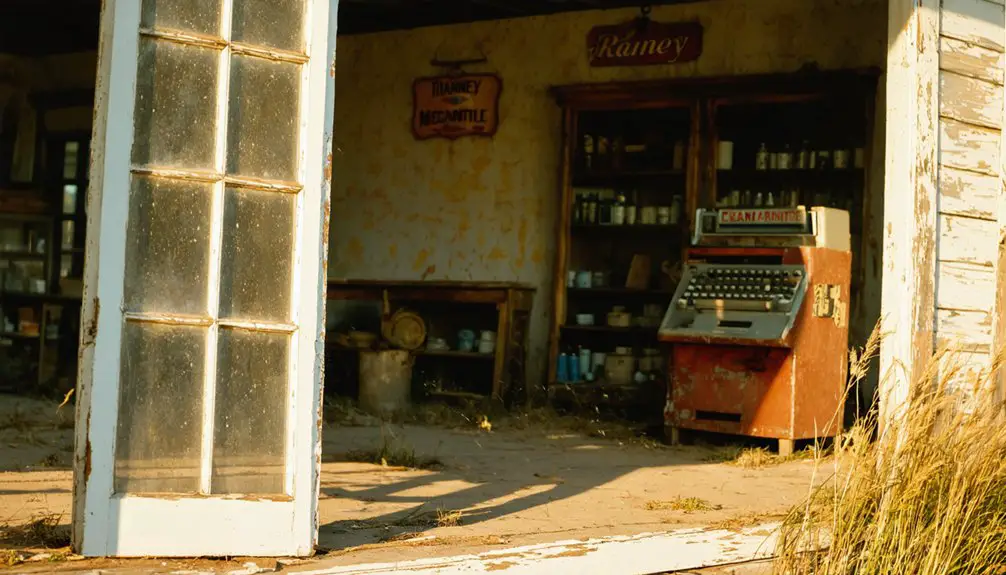
From the late 1800s through the early 1900s, Ranney’s fate mirrored many Wisconsin settlements that relied too heavily on single industries. The town’s economic vulnerability became apparent as younger workers sought opportunities in larger urban centers connected by rail lines, triggering dramatic demographic shifts that would ultimately seal its fate.
You’ll recognize three key factors that led to Ranney’s decline:
- Its dependence on a narrow economic base left little room for adaptation when industries changed.
- Being bypassed by major rail routes isolated the community from crucial trade networks.
- The exodus of working-age residents to cities offering diverse job prospects created an aging population.
Unlike nearby towns that diversified their economies, Ranney couldn’t compete with the draw of urban manufacturing jobs and better infrastructure, leading to its eventual abandonment.
What Remains Today
If you visit Ranney’s former location today, you won’t find a single building standing, as the last structure – the KD Line yardmaster’s house – came down in 2003.
The site has been completely cleared, with no visible foundations or historical markers remaining to hint at the railroad community that once thrived there.
While some Wisconsin ghost towns still feature crumbling ruins or preserved buildings, Ranney has become what locals call a “barren site,” with its history now preserved mainly in county historical society records rather than in physical remains.
Physical Structures and Foundations
While Ranney’s heyday as a bustling railroad community has long passed, the ghost town‘s physical remnants still dot the landscape within Pleasant Prairie, Wisconsin.
Today, you’ll find foundational remnants where buildings once stood, telling the silent story of this abandoned rail stop. The last vestige of Ranney’s occupied era – the KD Line yardmaster’s house – met its end in 2003.
If you’re exploring the site, you’ll notice three key features:
- Concrete foundations scattered across the open terrain
- Old railroad bed traces, complete with surviving ballast and occasional ties
- Ground depressions marking former building locations
The surrounding vegetation has reclaimed much of the area, but careful observers can still piece together Ranney’s footprint through these lingering structural clues.
Historical Artifacts and Collections
The soil of Ranney holds countless treasures for those who know where to look. You’ll find square nails, rare coins, and trade tokens scattered throughout former business districts and gathering spots, each artifact telling its own story of the town’s bustling past.
The artifact significance lies in what these objects reveal about daily life – from mining tools that speak to the town’s industrial heritage to saloon tokens that paint a picture of social connections.
Collection challenges are substantial, as nature’s reclamation efforts have buried many items beneath years of dust and overgrowth.
While some artifacts have been preserved by local historical societies, others remain untouched, waiting for discovery.
Like many Wisconsin ghost towns, Ranney’s material culture faces ongoing threats from treasure hunters and environmental degradation.
The Last Days of a Wisconsin Town
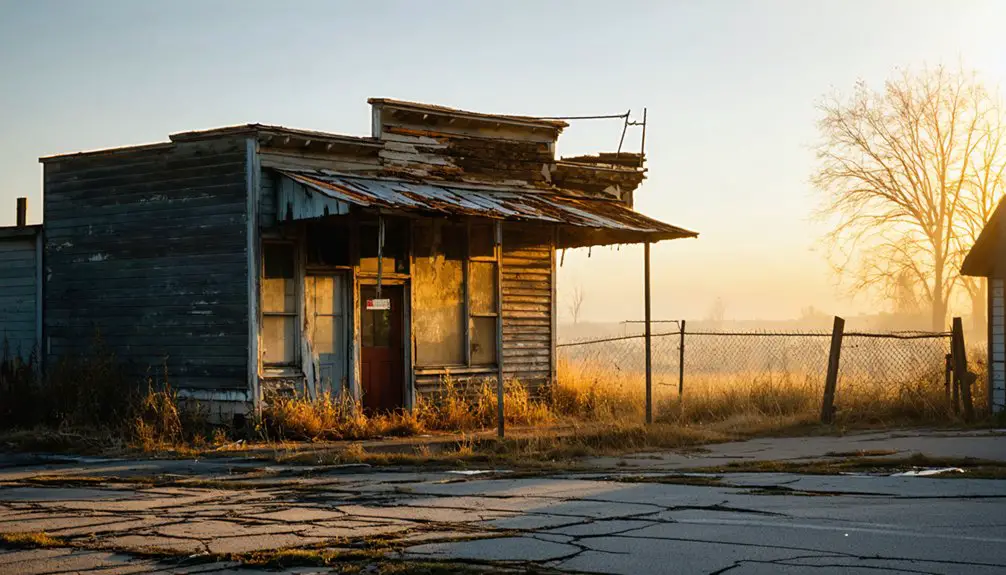
During its final years, Ranney’s slow descent into ghost town status became increasingly apparent as farm consolidation by large agricultural conglomerates swallowed up roughly 100 small family farms that once dotted the landscape.
Family farms vanished as corporate agriculture spread across Ranney, transforming a vibrant community into an empty shell of its former self.
You’d have witnessed the town’s heritage slip away as families moved out and businesses shuttered their doors one by one.
The final chapter of Ranney unfolded in three distinct phases:
- The Union Telephone Company’s services dwindled as fewer residents remained
- Last community events faded away as social bonds weakened
- The post office, gas station, and local stores closed their doors permanently
What you’ll find today are silent reminders of a once-thriving community – abandoned buildings, empty homes, and historic cemeteries that tell the story of Ranney’s transformation from bustling rural town to Wisconsin ghost town.
Preserving Ranney’s Memory
Despite Ranney’s physical decline, dedicated historians and community members have worked tirelessly to keep its memory alive through various preservation initiatives.
You’ll find community storytelling events where descendants share personal tales of life in the old town, while local historical societies carefully maintain digital archives of photographs, maps, and documents from Ranney’s heyday.
Volunteer groups help stabilize remaining structures using period-accurate materials, and you can explore interpretive walking trails with signs marking significant spots.
School groups often visit for hands-on history lessons, and living history demonstrations bring the past to life.
While funding challenges and weather continue to threaten what’s left of Ranney, passionate locals keep organizing preservation campaigns and recording oral histories to guarantee this slice of Wisconsin’s past won’t be forgotten.
Frequently Asked Questions
How Did the Original Settlers Choose This Specific Location for Ranney?
Picture pioneers scanning fertile valleys – you’d find early settlers chose this spot for its rich timber resources, strategic position near transport routes, and promising agricultural land that promised independence.
Were There Any Notable Crimes or Incidents in Ranney’s History?
You’ll find Ed Gein’s murder of Bernice Worden at her hardware store dominates the town’s unsolved mysteries and historical events. It’s the darkest chapter in local memory, overshadowing other incidents.
What Native American Tribes Originally Inhabited the Ranney Area?
You’ll find the Chippewa (Ojibwe) were the primary Native tribe near Ranney, though evidence shows the Ho-Chunk and Menominee peoples also left their cultural heritage throughout this region of Wisconsin.
Did Any Famous People or Historical Figures Visit Ranney?
You won’t find records of any famous visitors to this area. The town’s main historical significance comes from Ed Gein’s crimes, though he was a resident rather than a celebrated guest.
What Was the Peak Population of Ranney During Its Most Prosperous Years?
You’d be amazed how population growth brought up to 100-250 folks during peak prosperity, though that’s our best estimate given limited records, before economic decline emptied this once-bustling settlement.
References
- https://www.ghosttowns.com/states/wi/ranney.html
- http://shunpikingtoheaven.blogspot.com/2016/05/a-wisconsin-ghost-town.html
- https://upnorthnewswi.com/2024/02/21/the-fascinating-stories-behind-7-wisconsin-ghost-towns/
- https://pbswisconsin.org/news-item/southern-wisconsins-ghost-towns-leave-behind-vital-stories/
- https://www.dvidshub.net/news/294328/fort-mccoy-artifact-ranneys-wisconsins-finest-ice-cream-carton
- https://www.wisconsinhistory.org/Records/Article/CS1744
- https://pulitzercenter.org/stories/milk-strikes-1933-were-worst-year-wisconsin-dairy-farms-and-culminated-farmers-death
- https://en.wikipedia.org/wiki/History_of_Wisconsin
- https://search.library.wisc.edu/digital/A2QKU7USL3OZ7Z8O/pages/ASDPAMOKYDDWPQ8P?as=text&view=scroll
- https://www.youtube.com/watch?v=g-HCj1d5OSk
